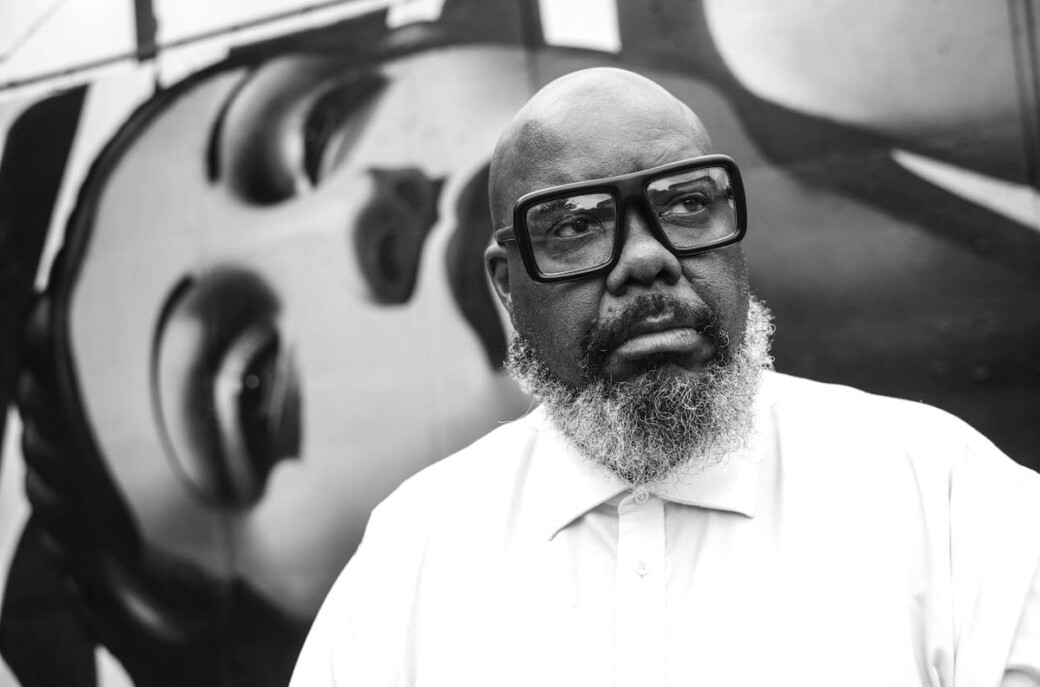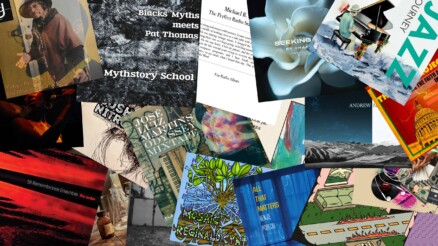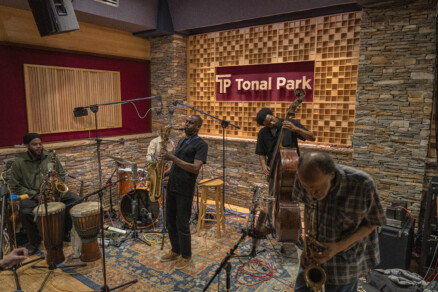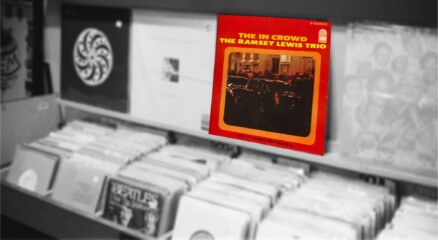Kokayi’s adventures in ‘spontaneous composition’

Kokayi is a multi-discipline creative force who launched from D.C. and has touched the world in many ways over a lengthy career. From his start as an underground hip-hop destroyer of microphones, his roles expanded to include bandleader, producer, visual artist and — increasingly — in-demand collaborator in the wide world of jazz. As an expert improviser on the microphone, whose practice revolves around the art of the freestyle, he’s able to facilitate a natural conversation between hip-hop and jazz where sometimes those attempts can be rote or forced.
Trumpeter Ambrose Akinmusire has followed a somewhat parallel path in broadening his fluency through multiple modalities. Where Kokayi started in hip-hop and gradually ventured outward, Akinmusire has been adding more dimensions around his nucleus in jazz. They both have a voracious spirit in exploring forms and dissolving the boundaries between them, with their resulting works speaking both to tradition and possibility.
The two artists’ paths coincide on Akinmusire’s 2025 album honey from a winter stone. On this newest collaboration, Kokayi weaves improvised vocals that range from rapping to melodies to free verse, all over compositions that are weighty, thrilling and sometimes discordant in a way that sets up intriguing plot twists.
I recently sat down with Kokayi (whom I’ve known and worked with since the 1990s) to discuss his process on honey from a winter stone and the origins of his collaborations with Akinmusire.
CapitalBop: How did you originally cross paths with Ambrose Akinmusire, and how was honey from a winter stone born?
Kokayi: The connection started back in 1997 probably. I met Ambrose at the Stanford Jazz Workshop. He was in high school. Him and Jonathan Finlayson were actually in that class. I was out there with Steve Coleman doing a residency in Oakland. We were faculty at Stanford. Me, Sub Z and Black Indian.
You have these places where you intersect with people and just have serendipitous interactions. You run across somebody who’s important in your life, or you find some sort of commonality with and then you run across them again, hopefully.
CB: Had you been keeping track of his career since that workshop, or had you not reconnected since then?
K: If you do music out here, especially in jazz circles, you’re gonna run across certain people. I didn’t know everybody in Ambrose’s band or what the music sounded like, but I knew him, and I was familiar with him.
CB: So how did you get the call to get on the record?
K: I was touring with Steve and I was working with Terri Lyne [Carrington]. I got a call to go do this gig in Australia with Ambrose. The rapper [Kool A.D.] from Das Racist on the first Origami Harvest record couldn’t make it on the tour. So next thing you know, I do the tour in Australia then I do the tour in Germany. Then he was like, “when we do Origami Harvest, you in the band.” And I feel like anytime you get these invitations, it’s how easy you are to work with and what you bring to the stage. We both love coffee. We was hanging out. He’s from the Bay. I’m from D.C. A lot of similarities there, you know. And so we kicked it, and then this record came about. Origami Harvest had a show in Minnesota and made a record after that.
CB: Did this record consist of stuff that y’all were consistently doing, or was it all fresh? It was all in one day, right?
K: Yeah, it was a one day joint. He introduced some stuff in Minnesota. And before that, he had a couple tunes.
CB: So all the people in this were in that ensemble?
K: Yes. Origami Harvest is Mivos Quartet, Marcus Gilmore on drums, Sam Harris on piano. The new person was Chiquitamagic. She brings the double synthesizer, analog, funk shit. [Ed. note: Justin Brown plays drums on honey from a winter stone.]
We played the full songs in Minnesota. Ambrose is an amazing composer. He wrote everything, bro, all the string shit is Ambrose. All the drum chants is Ambrose, everything is Ambrose.
CB: The string stuff is heavy.
K: It’s super heavy. I feel like he’s one of the best composers out right now. His compositions are bonkers.
CB: It seems like he’s on an arc with these releases on Nonesuch. How do you fit into that?
K: I’m asked to bring my specific sort of flavor, which is spontaneous composition through lyrics. My method is to talk to the composer about what they want to relay in the music. What are you trying to say in this song?
Like “muffled screams.” He had an incident where he felt like he died in his sleep. He was frozen. He couldn’t breathe. He couldn’t see anything. There was a yellow light, and then a green light, and then he took a breath, and he woke and said the thing that brought him back was thinking about his son. That was the information I needed to go ahead and think about. I’ve had moments like that, where you’re frozen and you feel like you can’t move, and you feel like you can’t breathe. And what does that really mean? And then having kids myself, thinking what would happen if I died. So that’s how that song came about.
Before we did the concert, I was asking about the songs. This one’s about angst. And what’s this one about, “s-/Kinfolks”? That’s definitely African American vernacular. We know all skin folk ain’t kinfolk, right? Even “Bloomed” which I’m not on, in concert, he’d be like, “Yo, jump in on this joint.” All the songs we’ve discussed, as far as lyrics are concerned. And some things are just how we’re thinking that day. “muffled screams” on the album would definitely not be “muffled screams” in concert.
CB: Whether stage or studio, you have an emotional palette to draw from. That’s style and content. What about form?
K: There’s no dictation about form. It’s however I feel.
CB: Because when I listen to this record I hear stated themes and sections that may completely change, and then it’ll be you. Is it you getting in where it makes sense, in the moment?
K: When we recorded this, I was in the control room. Everybody else was in the main room. Justin was in the drum booth. Chiquita was on the left hand side. I’m looking at the back of the heads of Mivos. Sam was at the grand piano to the right. And then Ambrose was in the middle of the room conducting.
Everybody has charts, and when we’re rehearsing it, he’ll be like, “I think this is where you should probably pop in”. Or just, “Do you.” It’s very loose but he trusts what I do, and I trust what he does.
All of the movements that are in there, all of that is composed. What Chiquita is playing is composed, but she memorizes all of the music. She doesn’t have sheets. And then for my portion, I know the vamp section that might come in. I have to credit this to working with Steve. It’s the call and response of each of the instruments. I know what the call is that’s supposed to be responded to by the drummer, and then I know when I’m supposed to come in.
CB: I knew that Ambrose was an M-Base alum and “MYanx” feels connected to that pocket you’ve worked in.
K: I mean it’s familiar, but yes and no, right? Creative, expansive music exists. I feel like each of us who have gone through the crucible of working with Steve, you come out the other side with the odd meter approaches, all of that stuff. But there’s no one progenitor of creative music or odd time signatures. So it exists within that landscape but it’s completely and purely Ambrose.
CB: Those long, shifting ostinatos… are you counting?
K: I learned a long time ago not to count. The first gig I played with Steve back in ’94 – that’s when I stopped counting. What I tell every student: whenever you listen to any music from anybody, there’s a pulse in there, and that pulse I’ve thankfully been able to hear, and that’s what gives me the rhythm to go to. For me, it’s a combination between what the drums are doing and what the bass is doing, or a bass element.
For what I do, I like to play around with whatever everybody else is doing. So if I hear the key change vocally. I might change key with it, right? I might rhyme to what Justin is playing in terms of trying to match the kick and the snare. Or I remember what the violins played, or what Sam is playing on keys, I might try to rhyme to that. Or what Ambrose is playing, because he plays both the trumpet and then he has his own synth where he plays these floaty lines, which is super Bay and super hip-hop. And I’ll fall into that. There’s a lot of different things for me to rhyme to and I think that’s the challenge that I try to give myself.
It’s not just what the beat is, but what are the other conversations that could be had?
There’s a subject matter to it, and each instrument is providing their own input as part of the conversation. Where do I fit in the conversation? I can’t be motor mouth and talk over everybody, because that’s not a conversation, right? So I have to listen, and I have to respond like you do in a regular conversation.
CB: You always sound like a member of an ensemble and not “featuring Kokayi”.
K: The whole point is to fit. I like bands. I don’t necessarily like rappers with bands. I don’t necessarily like singers with bands. So if you’re a vocalist with a band, are you part of the band, or are you just a vocalist with a band? Earth, Wind and Fire is the band. It’s not Maurice White and Earth Wind and Fire, you know what I mean? So in that band, you’re gonna have that camaraderie and those conversations that go back and forth. I don’t even like to set up in front of the band. So if you look, I don’t want to be in nobody’s line of sight when they getting they thing off. Because we’re a band, yeah.
CB: So did you get this record in one take, or how was it flowing?
K: Uh, one take. One Shot Shorty. It was no rewinds on that jont. If something messed up in the section, it would start over from the beginning.
CB: So y’all were playing them all down.
K: Yup. Playing ’em down. That was it. Top to bottom. No punches, no overdubs, no comeback laters. Nah.
CB: That’s very traditional.
K: I don’t really like the term jazz anymore, but if we talking about the historical portion of what jazz is supposed to be about –improvisation and tunes and things of that nature, and going back to the times when you didn’t have the ability to go back and re-record – I appreciate being able to drop something one time. When you get that one time joint, then it’s like “Oh, that’s the magic.” That’s the extra, you know, because it’s done. What it is is what it is. Because that’s all records are anyway, right? Records are only snapshots of where you are at that specific time.
I still want to keep studying and finding out what’s up with improvisation. I feel like there’s a special space when you have people that can improvise at a high level. There’s a specific type of brain function that happens, that goes into the ideas and understanding of what language is and how we communicate with empathy, and how you can walk in the studio with people that have all different backgrounds and create amazing music that you never would have thought would have come out of those folks because of the energy that’s there. Is it a spiritual thing? A metaphysical thing?
CB: Do you have a favorite moment on this Ambrose joint?
K: My favorite moment was actually being in the studio with everybody. I hope that don’t sound corny, but for real, I love making some dope shit around good people. It ain’t nothing I said or nothing I played. Honestly, I like working with people who I’m a fan of what they do. I’m a fan of what Ambrose does, and I’m a cheerleader of him as a person, because he’s actually a good dude. He hit me up and said, Come on, let’s go up to Minnesota and do the show, and then we’re gonna make a record. That’s my favorite part. I remember the moments of what happened that day and then having this come out as a record. It’s like, yeah, everybody should be falling out. It was a dope experience.
And then we just did a short tour mid last year. Dog, that jont was amazing. It was so much fun playing the records after having done those records, and not revisiting them, and not knowing anything, and just going in and being like, yeah, man, we get to play this again.
CB: So not even really living with the material, just coming back to it kind of raw and playing it again. It has another life to it.
K: Yeah, because people change, personnel changes, right? Mivos has some personnel changes. We’ve changed. And then having space, but playing in these confined situations. We did two festivals with very strict time, and we were like, how we going to play all this shit in this little bit of time? I guess we’ll get it. And it was amazing. It was a good time.
CB: Other than being easy to work with, is there anything else you can point to about how you keep popping up on these records in these improvisational contexts that keep you active?
K: I’ll keep it a buck with you, dude. I’m always honored when the young’uns reach out, when Morgan [Guerin] reached out and was like, “Yo, you want to be on my record?” I was like, uh, hell yeah. But I worked with him with Terri Lyne, and the same thing happened with Milena Casado. She was like, Okay, would you be on this song? Absolutely, 100% right? And then being open and not coming to them like, old head telling them I’m gonna do this, and I’m gonna do that, and then you gonna take it! What’s the song about? What’s your vision? What are you thinking? I’ll write something. And, you know, for Morgan and for Milena, I wrote something. And then for Jamie Baum, I wrote. I did three shows at the Blue Note with Nate Smith, Tim Lefebvre, Jason Lindner, and the next day we went to the studio. That was all improv, right? But my first record with Nate, I wrote. It’s like whatever the situation calls for. I’m just humbled to be asked to come be on these records, and then it just so happens that those records wind up getting a lot of attention, and I actually play with really dope people.
CB: The last thing that I would ask you, as somebody who’s seen decades of you working in many different contexts, do you have an agnostic, unified approach to all these different Kokayis that can hit the gig?
K: It’s the toolkit. If you’ve put in your 10,000, 20,000, 30,000 hours, you’ve learned your process. I I feel the same way when I walk into groups now and I’m asked to contribute. The process is, come in and check all your ego and bullshit at the door. Listen first, before you say a word. Listen to what the person wants. Ask them what their expectation is, ask them about the music and the thing. And can I do what I do? So if they’re familiar with me, they be like, “Do you.”




